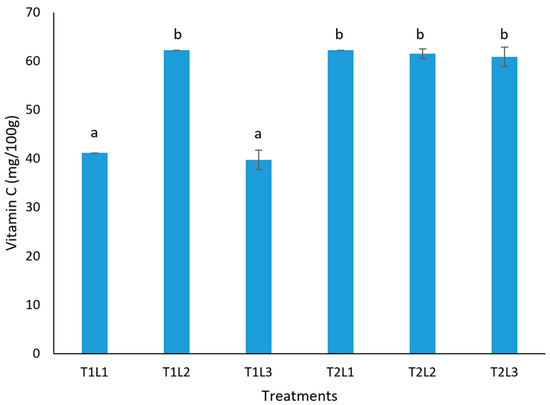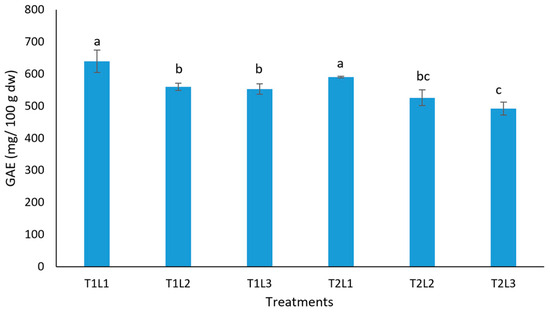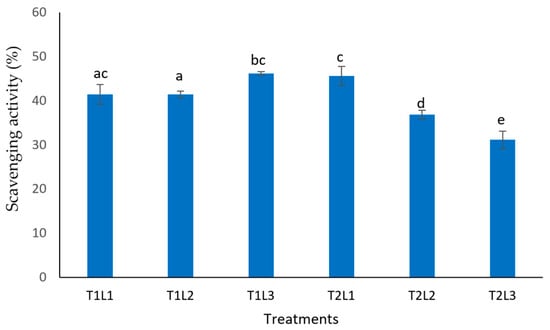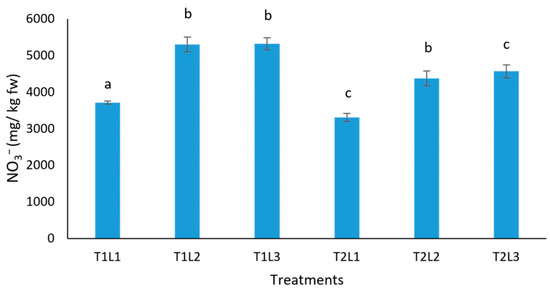Abstract
Vertical Farms (VFs) are controlled indoor growing systems that maximize crop production and land-use efficiency. The major disadvantage of VFs is the high energy demand for lighting, making it necessary to adopt light conditions that offer desirable traits to the plants under minimum energy consumption. The aim of this study was to evaluate nutritional factors of corn salad plants under different lighting conditions. Two different light qualities were tested, white and blue-red-near-infrared parts of the spectrum under three different daily light integrals, DLI, each. The optimal biochemical characteristics of the plants were observed under the most energy efficient lighting.
1. Introduction
Vertical farms (VFs) are fully insulated indoor constructions that facilitate the cultivation of vegetables stacked in levels, under controlled environmental conditions. VFs allow the production of food in an environmentally friendly way, independent of climate conditions, potentially without the need for pesticides or fertilizers [1]. VFs were developed as an answer to the problems of traditional open-field agriculture and greenhouses, that have large needs for irrigation and arable land, as well as full exposure to unpredictable and severe weather phenomena, and occur more and more often [2]. VFs offer a 70% reduction in water used for irrigation, which may reach 90% for hydroponic cultivation [3]. Moreover, VFs can be installed in the urban areas, where almost 70% of the human population lives, greatly reducing transportation costs and carbon dioxide emissions resulting from transportation [2]. One of the most important features of VFs is that they allow the farmer to fully control the environmental conditions, like temperature, lighting, and humidity, adjusting them according to the needs of each cultivation, achieving maximum yield and product quality [4]. Unfortunately, this leads to the biggest disadvantage of VFs, which is the high energy cost for lighting operation. Researchers estimated that cultivating plants in VFs requires 30 times more energy than cultivating in open fields [5]. To address this issue, it is necessary to find lighting conditions that are energy efficient and facilitate the growth of plants with desirable nutritional properties to meet the market needs.
The aim of this study was to evaluate the nutritional factors of corn salad (Valerianella locusta) plants, like ascorbic acid, polyphenol content, antioxidant activity and nitrate concentration, under different lighting conditions in order to find the lighting conditions that offer the optimal nutritional values.
2. Materials and Methods
2.1. Plant Material and Growing Conditions
The experiments were conducted in a pilot VF located at the campus of Agricultural University of Athens, Greece. The VF was installed inside a 40 ft cube with external dimensions of 12 m (L) × 2.44 m (W) × 3 m (H). The VF was equipped with 2 growing towers (T1, T2) and 3 growing layers (L1, L2, L3) per tower. Corn salad (Valerianella locusta) plants of the ‘Elixir’ cultivar (HM Clause S.A., Portes les Valence, France) were transferred in the VF on rockwool 14 days after germination. In the VF, plants were cultivated at 25 °C, 500–600 ppm CO2 and 50–55% relative humidity for 30 days, using a close-loop ebb and flow hydroponic system. All growing layers were irrigated simultaneously twice a day, for 10 min each time, with water enriched with nutrient solution at pH 5.6, that was then returned to the tank of the tower. Two different light qualities were applied, white and blue-red-near-infrared (B-R-NIR) parts of the spectrum, one at each tower using LED lamps. Three treatments (in the three growing layers, Table 1) were performed under each light quality, resulting in six different conditions. The plants were harvested on the 30th day of the light treatment.

Table 1.
The conditions applied under each light quality.
2.2. Reagents and Chemicals
Methanol, Folin–Ciocalteu reagent, DPPH and H2SO4 were purchased from Sigma-Aldrich (St. Louis, MO, USA). Ascorbic acid, potassium nitrate, salicylic acid and oxalic acid were obtained from Penta (Prague, Czech). Sodium hydroxide was purchased from Applichem (Darmstadt, Germany) and 2,6-dichloroindophenol sodium salt hydrate from Carbosynth (Compton, UK).
2.3. Determination of Ascorbic Acid
The content of ascorbic acid (vitamin C) was determined using Tillman’s method [6,7]. Freeze-dried plant material (1 g) was homogenized with 50 mL of oxalic acid solution (2%) and titrated with 0.1% 2,6-dichloroindophenol sodium salt hydrate, until the presence of a rosy color for more than 5 s. The results were expressed as mg of ascorbic acid per 100 g of dry weight (dw).
2.4. Extraction of Phenolic Compounds
Using 80% methanol as solvent, phenolic compounds were extracted from freeze-dried plant material in accordance with Fukumoto and Mazza’s 2000 method [8] with some modifications. Samples of 0.2 g of plant material were homogenized with 5 mL of 80% methanol and sonicated for 10 min in an ultrasonic water bath. After centrifugation at 3000× g for 15 min, the supernatant was collected. The extraction procedure was repeated five times. The supernatants were combined and evaporated to dryness under air nitrogen flow. The residue was dissolved in 5 mL of 100% methanol. These extracts were used for the determination of total phenolic content and antioxidant capacity.
2.5. Total Phenolic Content
Total phenolic content (TPC) was determined using Folin–Ciocalteu reagent as described by Petkovsek et al., 2010 [9]. Gallic acid was used as standard and TPC was expressed in mg of gallic acid equivalents (GAE) per 100 g of dry weight.
2.6. Determination of Antioxidant Activity
The ability of the extracts to react with radical of 2,2′-diphenyl-1-picrylhydrazyl (DPPH) was used to determine their antioxidant activity. In the DPPH assay, the reaction mixture consisted of 25 µL of the extract or standard solution and 975 µL of a 0.1 mM solution of DPPH. After incubation in the dark at room temperature for 30 min, a reduction in optical density compared to the control was observed at 517 nm [10]. The absorbance was measured using a Shimadzu UV-2600 spectrophotometer (Kyoto, Japan). Results were expressed as the percentage of DPPH neutralization.
2.7. Determination of Nitrate (NO3−) Contents in Leaf Tissues
The concentration of NO3− in the samples was determined according to the method described by Fatkullin et al., 2021 [11] with some modifications. A total of 1 g of fresh sample was extracted with 5 mL deionized water and boiled at 100 °C for 20 min. The samples were centrifuged at 15.871× g for 10 min, and 0.1 mL of the supernatant was mixed with 0.4 mL of 5% (w/v) salicylic acid in concentrated H2SO4. After 20 min incubation at room temperature, 9.5 mL of 8% (w/v) NaOH solution was added. The samples were cooled to room temperature (about 20–30 min) and NO3− concentration was determined spectrophotometrically by measuring the absorbance at 410 nm. The NO3− concentration was calculated using linear regression analysis using standard solutions of KNO3 (10–120 mg/L). The results were expressed as mg per 100 g of fresh weight (fw).
2.8. Statistical Analysis
For each biochemical analysis, triplicate measurements were conducted, and data were expressed as mean value ± standard deviation (n = 3). Statistical analysis was performed using unpaired t-test (GraphPad, San Diego, CA, USA), while p-value significance threshold was 0.05 (p ≤ 0.05).
3. Results
A biochemical analysis revealed the nutritional properties of the plants under each different light treatment. Vitamin C levels differentiated between the white light treatments, exhibiting maximum levels at the second layer (DLI 14.4 mol m−2 d−1) and minimum levels at the other two, while the maximum value was observed in all treatments under B-R-NIR light (Figure 1). Polyphenol levels were significantly higher at the first layer of each tower, at DLI 8.6 mol m−2 d−1, dropping by approximately 11% at the other layers with higher DLI values (Figure 2).

Figure 1.
Concentration of Vitamin C under each light treatment. Different letters indicate statistically important difference (p ≤ 0.05).

Figure 2.
Concentration of gallic acid equivalents under each light treatment. Different letters indicate statistically important difference (p ≤ 0.05).
The estimation of the plants’ antioxidant activity revealed an opposite pattern for the two light qualities. Under white light, the antioxidant activity was rising as DLI increased, reaching the highest value at the maximum DLI of 20.2 mol m−2 d−1. On the other hand, under B-R-NIR light, the antioxidant activity dropped as DLI increased, exhibiting the highest value at the minimum DLI of 8.6 mol m−2 d−1 (Figure 3). The nitrate concentration was at the lowest levels at the first layer of each tower, meaning at DLI 8.6 mol m−2 d−1 under both light spectra. More specifically, the lowest value was measured at 3995 mg/kg fw in T1L1 and then at 4926 mg/kg fw in T2L1. An increase in the DLI led to an increase in nitrates under both light qualities (Figure 4).

Figure 3.
Scavenging activity of each sample under each light treatment. Different letters indicate statistically important difference (p ≤ 0.05).

Figure 4.
Concentration of NO3− under each light treatment. Different letters indicate statistically important difference (p ≤ 0.05).
As a result from all measurements, it can be assumed that the lighting condition that offered the most desirable traits, which are a high concentration of ascorbic acid, polyphenols and antioxidants, but a low concentration of nitrates, was DLI of 8.6 mol m−2 d−1 under B-R-NIR lighting. This condition was also the most energy efficient, since it used the lowest PPFD values, as was confirmed by the estimation of the kWh (kilowatt hour) consumed.
4. Discussion
Antioxidants, polyphenols and ascorbic acid are of great interest to the food industry as they offer high-quality products with elevated market value [12]. Thus, these traits were evaluated in this study, in order to find the lighting conditions that are energy efficient and offer desirable values. Studies of other cultivars of corn salad have shown high values of ascorbic acid and polyphenols, under blue and red lighting at a PPFD value of 200 μmol m−2 s−1. Our study is in accordance with this, since we reported an optimal PPFD value at 150 μmol m−2 s−1 under B-R-NIR light [6]. More studies have highlighted the beneficial effects of red and blue LED light at a PPFD value of 200 μmol m−2 s−1 on various aspects of corn salad, like carotenoids, yield, ascorbic acid and antioxidant activity [13].
Nitrate concentration is also crucial in green leafy vegetables, since elevated levels are dangerous for human consumption. The European Union has set the acceptable upper limits for nitrate content in green leafy vegetables, like lettuce, spinach and rucola, but not corn salad [14]. V. locusta is considered a plant that accumulates large quantities of nitrates and some countries have set limits at, for example, 3500 mg/kg fw in Belgium or 2500 mg/kg fw in Germany [13]. In our study we monitored a range of 3995–6457 mg/kg fw, where the lower values are in accordance with studies reporting a range of 3118–4169 mg/kg fw [15] or 3878–4695 mg/kg fw [16]. Other researchers showed that LED light at percentages of 80% red and 20% blue, at a PPFD value of 200 μmol m−2 s−1, reduced the nitrate levels in corn salad of two other cultivars [6,13]. In our study, the lowest levels under B-R-NIR lighting were observed at a PPFD value of 150 μmol m−2 s−1. The optimization of the conditions is required to further reduce nitrate concentration down to acceptable levels.
Additional lighting in layers 2 and 3 did not seem to have a positive effect in any of the biochemical properties studied in the current research. This is a positive outcome, since it is desirable to have the best nutritional properties under the minimum energy cost, which is accomplished by using the minimum value of PPFD and was further confirmed by calculating the kWh consumed by each layer.
Author Contributions
Conceptualization, D.D.A. and A.A.; methodology, S.D. and K.T.; formal analysis, N.M.; investigation, N.M. and S.D.; data curation, N.M. and S.D.; writing—original draft preparation, N.M. and S.D.; writing—review and editing, N.M.; supervision, D.D.A. and A.A.; project administration, D.D.A. and A.A.; funding acquisition, D.D.A. and A.A. All authors have read and agreed to the published version of the manuscript.
Funding
This research has been co-financed by the European Regional Development Fund of the European Union and Greek national funds through the Operational Program Competitiveness, Entrepreneurship and Innovation, under RESEARCH–CREATE–INNOVATE (project code: T2EDK- 02663-VF2FARM).
Institutional Review Board Statement
Not applicable.
Informed Consent Statement
Not applicable.
Data Availability Statement
Data available on request due to restrictions, e.g., privacy.
Conflicts of Interest
The authors declare no conflict of interest.
References
- Van Gerrewey, T.; Boon, N.; Geelen, D. Vertical Farming: The Only Way Is Up? Agronomy 2022, 12, 2. [Google Scholar] [CrossRef]
- Vatistas, C.; Avgoustaki, D.D.; Bartzanas, T. A Systematic Literature Review on Controlled-Environment Agriculture: How Vertical Farms and Greenhouses Can Influence the Sustainability and Footprint of Urban Microclimate with Local Food Production. Atmosphere 2022, 13, 1258. [Google Scholar] [CrossRef]
- Al-Kodmany, K. The Vertical Farm: A Review of Developments and Implications for the Vertical City. Buildings 2018, 8, 24. [Google Scholar] [CrossRef]
- van Delden, S.H.; SharathKumar, M.; Butturini, M.; Graamans, L.J.A.; Heuvelink, E.; Kacira, M.; Kaiser, E.; Klamer, R.S.; Klerkx, L.; Kootstra, G.; et al. Current Status and Future Challenges in Implementing and Upscaling Vertical Farming Systems. Nat. Food 2021, 2, 944–956. [Google Scholar] [CrossRef] [PubMed]
- Van Ginkel, S.W.; Igou, T.; Chen, Y. Energy, Water and Nutrient Impacts of California-Grown Vegetables Compared to Controlled Environmental Agriculture Systems in Atlanta, GA. Resour. Conserv. Recycl. 2017, 122, 319–325. [Google Scholar] [CrossRef]
- Długosz-Grochowska, O.; Wojciechowska, R.; Kruczek, M.; Habela, A. Supplemental Lighting with LEDs Improves the Biochemical Composition of Two Valerianella locusta (L.) Cultivars. Hortic. Environ. Biotechnol. 2017, 58, 441–449. [Google Scholar] [CrossRef]
- Tauber, H.; Kleiner, I.S.; Mishkind, D. Ascorbic Acid (Vitamin C) Oxidase. J. Biol. Chem. 1935, 110, 211–218. [Google Scholar] [CrossRef]
- Fukumoto, L.R.; Mazza, G. Assessing Antioxidant and Prooxidant Activities of Phenolic Compounds. J. Agric. Food Chem. 2000, 48, 3597–3604. [Google Scholar] [CrossRef] [PubMed]
- Petkovsek, M.M.; Slatnar, A.; Stampar, F.; Veberic, R. The Influence of Organic/Integrated Production on the Content of Phenolic Compounds in Apple Leaves and Fruits in Four Different Varieties over a 2-Year Period. J. Sci. Food Agric. 2010, 90, 2366–2378. [Google Scholar] [CrossRef] [PubMed]
- Feduraev, P.; Skrypnik, L.; Nebreeva, S.; Dzhobadze, G.; Vatagina, A.; Kalinina, E.; Pungin, A.; Maslennikov, P.; Riabova, A.; Krol, O.; et al. Variability of Phenolic Compound Accumulation and Antioxidant Activity in Wild Plants of Some Rumex Species (Polygonaceae). Antioxidants 2022, 11, 311. [Google Scholar] [CrossRef] [PubMed]
- Cataldo, D.A.; Haroon, M.H.; Schrader, L.E.; Youngs, V.L. Rapid Colorimetric Determination of Nitrate in Plant Tissue by Nitration of Salicylic Acid. Commun. Soil Sci. Plant Anal. 1975, 6, 71–80. [Google Scholar] [CrossRef]
- Fatkullin, R.; Naumenko, N.; Popova, N.; Ruskina, A.; Kalinina, I.; Potoroko, I. Explaining Consumer Intentions for Foods with Antioxidant Properties: Predictors of Choice and Purchase Barriers. Int. J. Food Sci. 2021, 2021, 9971425. [Google Scholar] [CrossRef] [PubMed]
- Wojciechowska, R.; Kołton, A.; Długosz-Grochowska, O.; Knop, E. Nitrate Content in Valerianella locusta L. Plants Is Affected by Supplemental LED Lighting. Sci. Hortic. 2016, 211, 179–186. [Google Scholar] [CrossRef]
- European Union COMMISSION REGULATION (EU) No 1258/2011. Available online: https://www.fao.org/faolex/results/details/en/c/LEX-FAOC108181/ (accessed on 1 September 2023).
- Iacuzzo, F.; Gottardi, S.; Tomasi, N.; Savoia, E.; Tommasi, R.; Cortella, G.; Terzano, R.; Pinton, R.; Dalla Costa, L.; Cesco, S. Corn Salad (Valerianella locusta (L.) Laterr.) Growth in a Water-Saving Floating System as Affected by Iron and Sulfate Availability. J. Sci. Food Agric. 2011, 91, 344–354. [Google Scholar] [CrossRef] [PubMed]
- Manzocco, L.; Foschia, M.; Tomasi, N.; Maifreni, M.; Dalla Costa, L.; Marino, M.; Cortella, G.; Cesco, S. Influence of Hydroponic and Soil Cultivation on Quality and Shelf Life of Ready-to-Eat Lamb’s Lettuce (Valerianella locusta L. Laterr). J. Sci. Food Agric. 2011, 91, 1373–1380. [Google Scholar] [CrossRef] [PubMed]
Disclaimer/Publisher’s Note: The statements, opinions and data contained in all publications are solely those of the individual author(s) and contributor(s) and not of MDPI and/or the editor(s). MDPI and/or the editor(s) disclaim responsibility for any injury to people or property resulting from any ideas, methods, instructions or products referred to in the content. |
© 2023 by the authors. Licensee MDPI, Basel, Switzerland. This article is an open access article distributed under the terms and conditions of the Creative Commons Attribution (CC BY) license (https://creativecommons.org/licenses/by/4.0/).